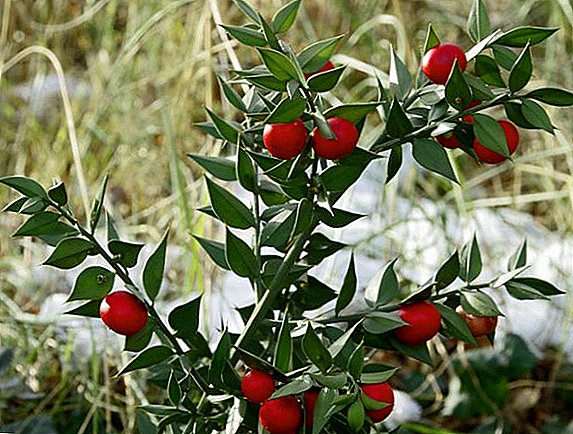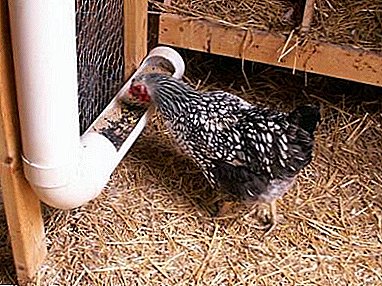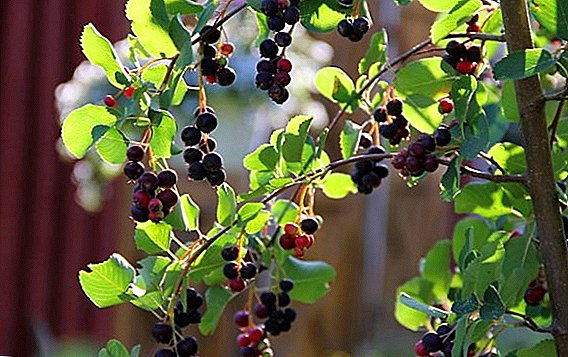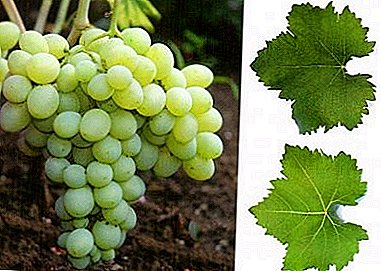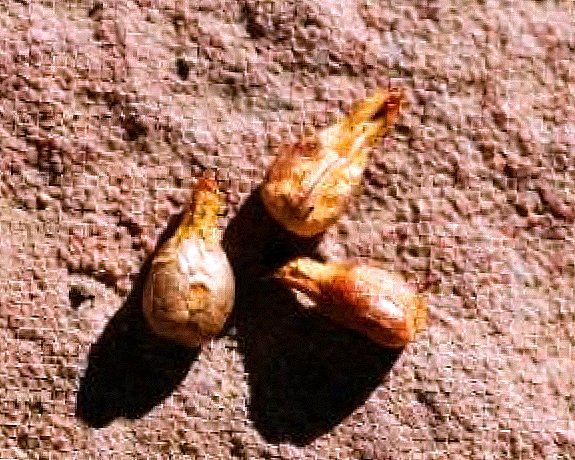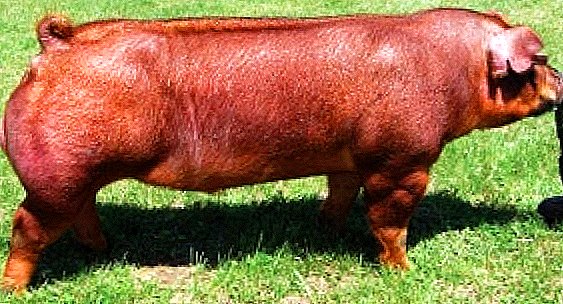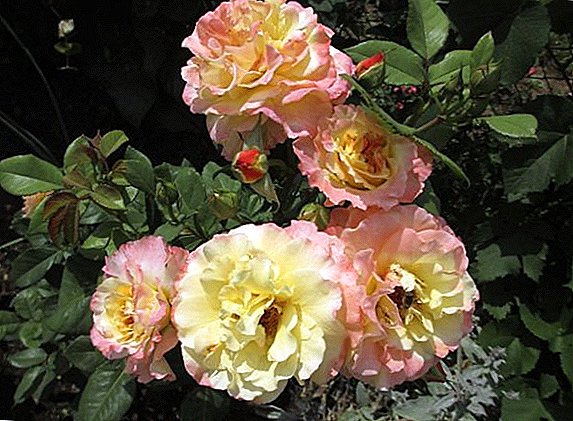 It is difficult to imagine a garden without a flower bed or flower beds, and a flower garden without the most popular shrubbery, a rose. Rose bushes everywhere are considered to be the favorites of gardeners, and the variety of varieties allows to satisfy even the most exacting taste. On the plots is often found rose varieties "Watercolor" - it is about it will be discussed: find out what lies behind this unusual name.
It is difficult to imagine a garden without a flower bed or flower beds, and a flower garden without the most popular shrubbery, a rose. Rose bushes everywhere are considered to be the favorites of gardeners, and the variety of varieties allows to satisfy even the most exacting taste. On the plots is often found rose varieties "Watercolor" - it is about it will be discussed: find out what lies behind this unusual name.
Biological description and appearance
The grade "Water color" is widely presented not only at dachas, but also on city beds. Surely many met him without even knowing what he was called.
Bush height
The bush of this variety does not have significant differences from other relatives: it is moderately spreading, with dark green leaves, of standard shape. The height of the shrub is usually 70-90 cm. 
Buds
The name "Watercolor" variety received due to the unusual color of the petals: nature has endowed the buds with hues that smoothly change from pale pink from the outside to peach and milk in the center of the flower.
10 frequent mistakes gardeners in the cultivation of roses.Petals copiously cover the bud, making it terry. Flowers are large, characteristic of hybrid varieties, reach a diameter of 10-12 cm, spherical in shape, are placed both singly and inflorescences in several pieces (most often in 7).
The aroma of "Watercolor" has a high intensity with a clear fruity notes, bright, which makes this variety very popular when creating the aromatic composition of the flower garden.
Did you know? The aroma of roses is a powerful natural antidepressant - regular inhalation allows you to cope with stress, calm down and relax.
Bloom
The shrub blossoms very abundantly and long, until late autumn, which is why it is often grown to decorate large flower beds and for cutting. 
We advise you to learn how to grow a rose in a pot.
Winter hardiness and disease resistance
This variety is very resistant to external influences, has an average immunity to many diseases characteristic of its fellows, especially resistant to such a disease as powdery mildew, but the winter hardiness is not the strongest side of the shrub, so it is recommended to always cover it for the winter.
Growing conditions
To grow a rose "Watercolor" is not difficult, if you follow the standard rules that are typical for most rose bushes:
- First of all, special attention is required soil for planting a bush. The plant loves the fertile soil of low acidity. Be sure to provide good drainage.
- The lighting should be intense, it is better to have a shrub in sunny areas, otherwise the buds can lose a pink tint.
- The place where the "Aquarelle" rose sapling is planted must be protected from drafts.
Important! The lack of lighting can significantly reduce the intensity of flowering roses and slow down the development of the plant as a whole.
Use in landscape compositions
The combination of rapid flowering and bright aroma allows using this variety in many garden compositions of various purposes. Roses look great in a flower bed, planted in small groups. Terry flowers, unusually colorful, perfectly play the role of the basis of the composition.
"Watercolor" is considered to be cut varieties due to its long and abundant flowering: in bouquets, the flower is kept very firmly. In addition, the bush is suitable for growing in boxes in closed rose gardens.
Cut roses for a bouquet can be dried for a beautiful composition or even grow a new rose with a cutting.
Rose Bush Care Tips
In order for the cultivation of roses to be fun, and they delight you throughout the season, in addition to choosing the right place, you need to take into account other flower care features:
- Earlier it was said that "Watercolor" has an average resistance to various diseases, but the likelihood of damage to the plant in the conditions of the garden, of course, exists. To avoid trouble, you need to regularly inspect the bushes, remove faded leaves and dried shoots, carry out preventive treatment from pests with special preparations;

Important! Try not to allow the neighborhood of roses with other rose plants: raspberry, cherry, pear. Also, do not plant a rose bush on the place where these cultures previously grew.
- It is equally important to properly organize the mode of watering the roses, because the lack of moisture affects the appearance and development of the plant - the leaves and flowers can wither and begin to dry out. Watering the rose during the summer period is necessary at least once a week, in spring and autumn the frequency of watering decreases to 1 time in 2 weeks. You can not flood the plant, it can lead to rotting of the roots;
- in order to maintain optimum soil moisture, experienced gardeners advise mulching the soil around the bush with peat;
- so that the shrub looks neat and continues to bloom abundantly, it is necessary to regularly trim the roses. In addition, timely trimmed bush becomes more resistant to fungi. Hybrid tea "Watercolor", usually cut several times. In the spring, the purpose of pruning is to form a shrub, remove old shoots, improve the appearance of the plant. Summer pruning performs its task: to clean the shrub from drying leaves, outdated buds. In the fall, roses are not always pruned, but only if necessary before hibernation;
- like any hybrid plant "Watercolor" needs regular feeding to continue its abundant flowering. Rose fertilizer is best done using ready-made industrial products. Depending on the time of year, different combinations of fertilizers are needed. So, in the spring, during the period of growth and development of buds, bushes are fertilized with potash and nitrogenous means, in the summer they combine mineral fertilizers and organic matter, and phosphorus-potassium complexes are suitable before the winter cold;
- Rose "Watercolor" has a moderate frost resistance and can withstand temperatures up to -9 ° C without shelter. Nevertheless, experts advise not to take risks and cover bushes for the winter, having previously prepared everything necessary. To do this, the bush is pruned, leaving low shoots (about 10 cm), then the plant should be tucked up and covered with foliage. You can build small "houses" for the bushes from the old wooden boxes, which will be covered with sacking. It is important to organize the insulation in such a way that it does not lead to the formation of dampness, otherwise the plant will die.

Familiarize yourself with the peculiarities of the choice of covering material and the methods of sheltering roses for the winter.

Did you know? If, when breeding roses, two varieties with a strong aroma are crossed, then the resulting hybrid will have flowers with a very faint odor or not at all.
So, we looked at the wonderful variety of roses with the romantic name "Watercolor", got acquainted with its description, peculiarities of cultivation and care. It should be noted that this hybrid, if properly treated, will bring magnificent aroma into your garden and will become a real decoration of the flower bed with minimal gardener's efforts.


